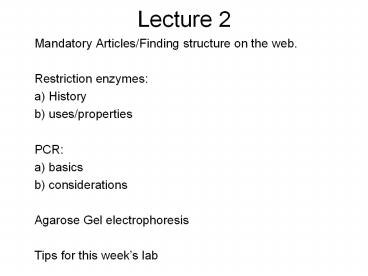Mandatory Articles/Finding structure on the web. - PowerPoint PPT Presentation
Title:
Mandatory Articles/Finding structure on the web.
Description:
Lecture 2 Mandatory Articles/Finding structure on the web. Restriction enzymes: a) History b) uses/properties PCR: a) basics b) considerations Agarose Gel electrophoresis – PowerPoint PPT presentation
Number of Views:66
Avg rating:3.0/5.0
Title: Mandatory Articles/Finding structure on the web.
1
Lecture 2
- Mandatory Articles/Finding structure on the web.
- Restriction enzymes
- a) History
- b) uses/properties
- PCR
- a) basics
- b) considerations
- Agarose Gel electrophoresis
- Tips for this weeks lab
2
Mandatory Articles
- Sept. 29 Article 1
- Oct. 6 Article 2
- Oct. 13 Thanksgiving
- Oct. 20 Article 3
- Oct. 27 Article 4
- Nov. 3 Article 5
- Nov. 10 Article 6
- Nov. 17 Article 7
3
Finding structures on the Web
- http//www.ncbi.nlm.nih.gov/
- Choose structures
- Search for the one you are interested in.
- Download file and viewer and look at your
structure.
4
(No Transcript)
5
(No Transcript)
6
(No Transcript)
7
(No Transcript)
8
(No Transcript)
9
(No Transcript)
10
(No Transcript)
11
(No Transcript)
12
Socratic Method
- Questions are the fundamental guiding element
that lead to answers, or boundaries to the
unanswerable. - Method of critical thinking/investigation.
- Development of student intellectual autonomy.
- I use a loose Socratic style in lecture.
13
Restriction enzymes
- Enzymes and recombinant DNA technology.
- How were restriction enzymes found originally?
- What are the properties of restriction enzymes?
- What are their uses?
14
Early 1970s Genomic Studies How to cut DNA into
manageable fragments? Chemical/mechanical means
non-specific, non-reproducible
Breakthrough needed
Restriction Endonucleases Molecular Scissors for
Cutting DNA
15
But where did restriction enzymes come from?
- They were discovered as a method of protecting
bacteria from bacteriophage infection. - Called the restriction modification system
16
(No Transcript)
17
(No Transcript)
18
(No Transcript)
19
(No Transcript)
20
(No Transcript)
21
(No Transcript)
22
Restriction Enzymes Recognize Palindromic
Sequences
23
Restriction enzymes
- Considerations
- Why do we have MgCl2 ?
- Why do we have NaCl?
- Why do we have a buffer?
24
(No Transcript)
25
Restriction enzymes can be used to create a MAP
of DNA
- Cleavage of DNA with restriction enzymes provides
landmarks and sequence information.
? MAP ?
26
Restriction enzymes can be used to create a MAP
of DNA
Restriction enzymes played a pivotal role in
cloning of the Human Genome
Digestion of DNA with restriction enzymes
cloning into vectors
Construction of restriction maps of individual
clones
27
FORMATION OF RECOMBINANT DNA
28
Polymerase Chain Reaction
- Considerations
- Why do we have MgCl2?
- Why do we have a buffer?
- Why do we have dNTPs?
- Why do we have primers?
- Why three temperatures per cycle?
29
POLYMERASE CHAIN REACTION
STEPS INVOLVED
Reverse Primer
Forward Primer
Taq Polymerase
30
Unlike most enzymes, Taq DNA polymerase can
withstand high temperatures necessary for DNA
strand separation and can be left in the reaction.
31
PCR Representative Temperature Profile
32
POLYMERASE CHAIN REACTION
AMPLIFICATION OF DNA
33
POLYMERASE CHAIN REACTION (Cont)
34
EXPONENTIAL AMPLIFICATION OF PRODUCT
35
DESIGNING PRIMERS
1. Primers should be 18-25 bases in length
2. Base composition should be 50-60 (GC)
3. Primers should end (3') in CG or GC this
creates tight ends and increases
efficiency of priming 4. Tm 4(G C) 2(A
T) oC Ta should be 2-5 oC below Tm( 55-60oC)
5. 3'-ends of primers should not be
complementary primer-dimer 6. Primer
self-complementary (ability to form hairpins)
should be avoided. 7. Three or more Cs or Gs
at the 3'-ends of may promote mispriming at G or
C-rich sequences (because of stability of
annealing), and should be avoided.
Adapted from Innis and Gelfand, 1991
36
Gel electrophoresis
- Considerations
- On what basis are molecules separated?
- How does a gel work?
- Which way do molecules go and why?
- What colour are electrodes and anodes?
37
AGAROSE GEL ELECTROPHORESIS
Agarose A polysaccharide extracted from
seaweed. Used to separate DNA fragments
based on size
38
Detecting DNA using Ethidium Bromide
Intercalates between bases of DNA
When excited by UV light, EtBr emits fluorescent
light at 590 nm EtBr is a very dangerous mutagen.
39
How are different sizes of DNA strands separated
on agarose gel?
Mixture of DNA molecules
40
DNA separation is based on fragment size
41
Size markers and their use to determine size
42
Size markers and their use to determine size
Mobility of a DNA fragment is proportional to
the log of its size in bases.
43
Plot of relative mobility of DNA vs log of size
on semi-log graph paper
44
Varying concentrations of agarose
How does one make a 0.7, 1.0 1.5 agarose
gel? Why are there varying concentrations of
agarose gels?
45
Varying concentrations of agarose
Why are there varying concentrations of agarose
gels? Higher concentrations provide better
resolution for smaller DNA fragments Lower
concentrations provide better resolution for
larger DNA fragments
46
Tips
- Major reason for this experiment not working is
not having all the reaction components in the
correct tube. - Tick list
- Droplets on tube wall
- Master Mix
47
Tick list
48
Droplet method
49
Droplet method
- Check pipet tip for solution.
- Eject solution on the side of tube.
- Check for a droplet.
- To get the solution in the droplet to the bottom
of the tube tap the tube on the bench.
50
Master Mix
- On the board.
51
(No Transcript)
52
(No Transcript)
53
100bp Cycle
ladder 5 10 15 20 25 30































